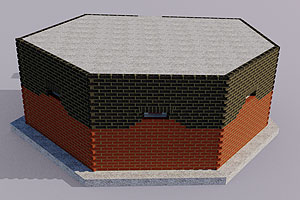Mystery of the tank in the sea
Posted: 25 April 2012 21:54
Locals have known for years of the remains of a WW2 tank off the Sussex coast, but mystery still surrounds the circumstances of how it came to be in the sea. A visit to the site reveals some scattered remains in the surf.
An expedition organised by Sussex Military History Society to record the remnants, managed to locate them under water on an isolated stretch of the coast. We're not revealing the location, even though we're satisfied that the sheer weight and unportability of the artefacts makes it highly unlikely that souvenir hunters would remove pieces from the site.
The surviving evidence
There were a total of three road wheels found; the one in photo 1 below was in the best condition; photo 2 is a vertical view of the same wheel.
Photo no.3 was looking more as you would expect a wheel to look like after 70 years in the sea, while the solid rubber tyres on the wheel in photo 4 were almost like new!

There were two short lengths of track; both rusted solid.

The most impressive piece was the mantlet - this was the front plate of the turret with slots for the main armament (centre), gunsight (left) and coaxial machine gun. The mantlet is actually lying upside down.

The oblique view below shows the curved shape of the plate.

The main armament (or at least, part of the barrel) lies a few yards away from the mantlet. Unfortunately, it was corroded almost solid, so no evidence of rifling or other identifying marks remained.

What type of tank is it and how did it get here?
It is one of the British Cruiser tanks; initial research indicates it may be a Covenanter.
The mystery as to how and why it got to its current location remains, although my documentary research has identified a date in a war diary when Covenanter tanks were training a couple of hundred yards north of the beach. This has lead to the identification of some unit war diaries that may hold the answer.
Is this Signalman Gardner's tank?
I wrote about the tragic circumstances of Signalman Alwyn Gardner's death in my 2009 Remembrance piece and have covered it in some of my talks.
Gardner was adjusting the brakes in a stationary tank on a cliff top at Friston in 1942, when it began to move down a slope under its own momentum and over the cliff edge. Gardner was rescued from the wreckage, but later died of his injuries.
We can immediately rule out the current remains as being that of Gardner's tank, as Friston is miles away!
The answer (if one can be arrived at) probably lies in local knowledge, but my next trip to TNA may give us more clues as to why this tank ended up in the sea!
- Pete

Email:
Blog Latest

Bishopstone reveals its pillbox secrets
18 October 2021

Pillbox or Observation Post?
10 June 2020

Uncovering the hidden secrets of a pillbox
8 June 2019

Review of 2018
31 December 2018

Wartime Christmas in East Sussex (2)
24 December 2018
Jargon-buster
TNA
The National Archives (formerly The Public Records Office or PRO).
War diary
A record of events kept by all units from the point of mobilisation. A diary's contents vary enormously from unit to unit; some give detailed entries by the hour on a daily basis while others merely summarise events on a weekly/monthly basis.
This site is copyright © Peter Hibbs 2006 - 2024. All rights reserved.
Hibbs, Peter Mystery of the tank in the sea (2024) Available at: http://pillbox.org.uk/blog/216696/ Accessed: 27 July 2024
The information on this website is intended solely to describe the ongoing research activity of The Defence of East Sussex Project; it is not comprehensive or properly presented. It is therefore NOT suitable as a basis for producing derivative works or surveys!